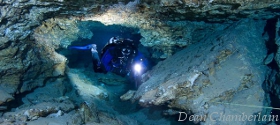|
Written by Agnes Milowka
|
|
Wednesday, 15 December 2010 07:55 |
|
 The Mt Gambier region of South Australia is famous for its numerous caves and sinkholes but Tank Cave stands out from amongst the crowd and is the crowning jewel as far as cave divers are concerned. Tank Cave, named so because a water tank used to rest right over the top of the entrance, is an extensive, maze like system with over 7km of passage which makes it one of the longest caves in Australia. The Mt Gambier region of South Australia is famous for its numerous caves and sinkholes but Tank Cave stands out from amongst the crowd and is the crowning jewel as far as cave divers are concerned. Tank Cave, named so because a water tank used to rest right over the top of the entrance, is an extensive, maze like system with over 7km of passage which makes it one of the longest caves in Australia.
The Tank Cave entrance is on private property and the Cave Divers Association of Australia (CDAA) strictly control access to the site. The complicated nature of the system (it looks like a spider web gone wild) requires a strict familiarization process that allows cave divers to get to know the cave step by step. While there are a lot of hoops to jump through before you allowed access to the site, on the upside this means that every cave diver is intimately familiar with all the main passages of Tank Cave before they venture off into the many side tunnels.
Sometimes cave divers worry that Tank Cave will prove to be a huge disappointment after all the fuss leading up to the first dive but even the gold line dives are quite exciting. Tank Cave in unlike any other in the Mt Gambier region, it is a real gem and it is a joy to dive. The cave is stunning, it is relatively shallow (a max depth around 20m), there is no flow to fight and the water is crystal clear - you can't go wrong really.
The best part of diving in Tank Cave however is that there is still plenty of potential for exploration. Whilst most people assume everything around the Mt Gambier region has been found and discovered this is definitely not so and is most certainly not the case in this cave. My second weekend there, whilst still doing familiarization dives, my buddy and I found going passage right off the gold line. It was a little hole but the tunnel quite clearly went. My buddy couldn't actually fit through the restriction initially, so he patiently waited for me as I went off to check out what was beyond the squeeze. In the end I laid almost 300m of line, so clearly there is a lot more new cave passage to be found in Tank Cave.
This new section comes off the end of the C line and it is most definitely a sidemount only passage. Depending on your size it might require you to take one tank off in order to pass through the initial restriction. The tight bits don't end with the first restriction however; there are a number of them before you finally reach a larger more open passage. The walls and roof to begin with are quite soft and squishy, which means that large chunks of the roof rain down on you as you exhale and the visibility is quickly reduced to zero. This is not only a hazard when coming back out through the small restrictions but it also means that this section of the cave is particularly fragile and needs to be handled with a bit of tender love and care.
In order to improve the quality of the survey I called in Ken Smith, the legendary 'Pinger Man.' The pingers are a part of an underwater radiolocation system that allows the location of the pinger underwater to be located from above ground. This helps to establish an accurate position for each survey station pinged with GPS accuracy and as such helps to tie in the remote sections of the cave with the existing map. We pinged four points that weekend and as such an accurate map is forthcoming.
Exploration is continuing in Tank Cave at the end of a number of tunnels, which makes this cave an exciting one to visit and top of my list when heading over to Mt Gambier. I'm sure you'll be hearing more about this cave as many more discoveries are yet to come. Perhaps one day the cave will break the magical 10km mark.
Further Information
|

 The Mt Gambier region of South Australia is famous for its numerous caves and sinkholes but Tank Cave stands out from amongst the crowd and is the crowning jewel as far as cave divers are concerned. Tank Cave, named so because a water tank used to rest right over the top of the entrance, is an extensive, maze like system with over 7km of passage which makes it one of the longest caves in Australia.
The Mt Gambier region of South Australia is famous for its numerous caves and sinkholes but Tank Cave stands out from amongst the crowd and is the crowning jewel as far as cave divers are concerned. Tank Cave, named so because a water tank used to rest right over the top of the entrance, is an extensive, maze like system with over 7km of passage which makes it one of the longest caves in Australia.